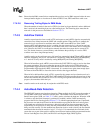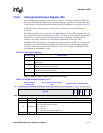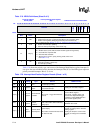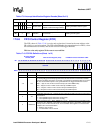
17-8 Intel® PXA255 Processor Developer’s Manual
Hardware UART
If the UART is to program the Divisor Latch registers, you can choose one of two methods for
auto-baud calculation: table-based and formula-based. Set Auto-Baud Control register (ABR), bit 3
(ABR[ABT]) to select which method you want to use (refer to Section 17.5.8). When the formula
method is used, any baud rate defined by the parameters in Section 17.5.3
can be programmed by
the UART. The formula method works well for higher baud rates, but could possibly fail below
28.8 kbps if the remote transmitter’s actual baud rate differs by more than one percent of its target.
The table method is more immune to such errors as the table rejects uncommon baud rates and
rounds to the common ones. The table method allows any baud rate defined by the formula in
Section 17.5.3
above 28.8 kbps. Below 28.8 kbps the only baud rates which can be programmed by
the UART are 19200, 14400, 9600, 4800, 1200, and 300 baud.
When the baud rate is detected, the auto-baud circuitry disables itself by clearing ABR, bit 0
(ABR[ABE]). If users want to re-enable auto-baud detection, ABR[ABE] must be set.
Note: Auto-baud rate detection is not supported with IrDA (slow infrared) mode.
See Section 17.5.8
for more information on auto-baud.
17.4.5 Slow Infrared Asynchronous Interface
The Slow Infrared (SIR) interface supports two-way wireless communication that uses infrared
transmission. The SIR provides a transmit encoder and receive decoder to support a physical link
that conforms to the Infrared Data Association, Serial Infrared Physical Layer Link Specification,
October 17, 1995, Version 1.1.
The SIR interface does not contain the actual IR LED driver or the receiver amplifier. The I/O pins
attached to the SIR only have digital CMOS level signals. The SIR supports two-way
communication, but full duplex communication is not possible because reflections from the
transmit LED enter the receiver. The SIR interface supports frequencies up to 115.2 Kbps. Because
the input clock is 14.7456 MHz, the baud divisor must be eight or more.
17.4.5.1 Operation
The SIR modulation technique works with 5-, 6-, 7-, or 8-bit characters with an optional parity bit.
The data is preceded by a zero value start bit and ends with one or more stop bits. The encoding
scheme is to set a pulse 3/16 of a bit wide in the middle of every zero bit and send no pulses for bits
that are ones. The pulse for each zero bit must occur, even for consecutive bits with no edge
between them.


















